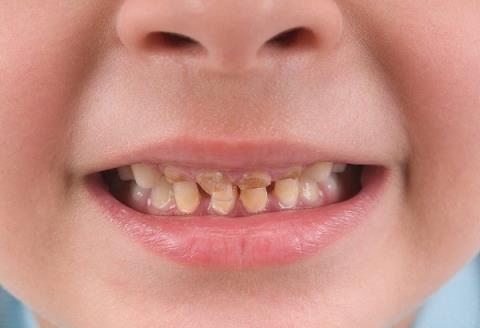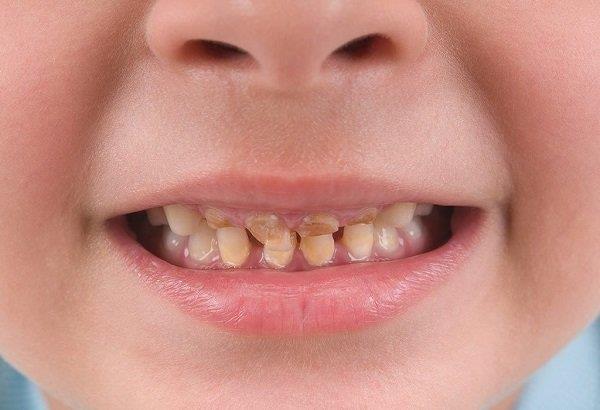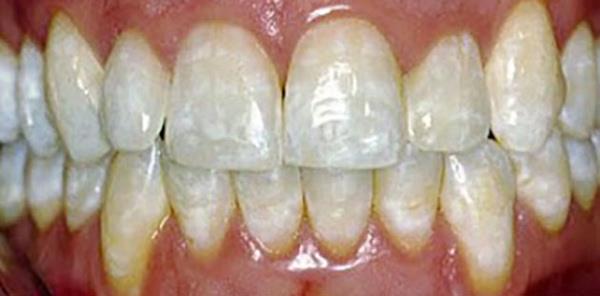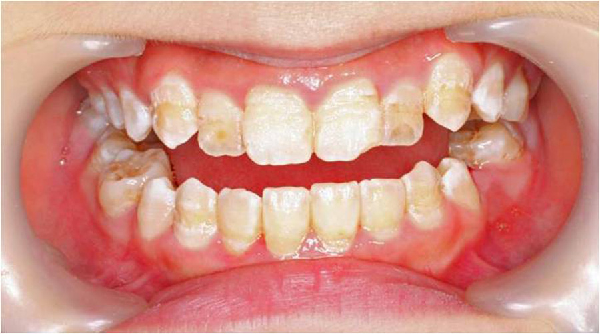Yellow and discolored teeth in children: causes, treatment and prevention

A child's innocent and beautiful smile is one of the greatest joys for parents, sometimes children can have yellow discoloration of their teeth, which can affect their beautiful smile. However, you should not be too worried because there are many different measures to improve the color of your baby's teeth. The following SignsSymptomsList article will talk about: causes, treatments, and different preventive measures you can take to improve yellow discoloration in your children's teeth.
content
- 1. What is the status of yellow teeth and discoloration?
- 2. What causes yellow teeth to change color in children?
- 3. Signs of tooth discoloration
- 4. Ways to treat yellowed and discolored teeth
- 5. Tips to prevent yellowed teeth from discolouring
- 6. When should you take your child to the doctor?
1. What is the status of yellow teeth and discoloration?
First of all, we have to understand exactly what yellow discoloration teeth are. Remember that baby teeth are usually whiter than their permanent teeth. Don't worry if their first adult teeth look pretty yellow compared to the rest of their baby teeth.
Tooth discoloration is when the natural ivory white of a tooth turns a dark yellow, yellow-brown or opaque gray. Tooth discoloration can be: external discoloration or internal discoloration.
External discoloration may be temporary ; and can happen due to some drugs, foods, etc., On the other hand, internal discoloration can happen mainly due to underlying pathologies like metabolic disorders, enamel hypoplasia, etc.

The status of yellow teeth and discoloration
2. What causes yellow teeth to change color in children?
If you are wondering why your child's teeth are yellow, the following causes can help you understand better.
2.1. Caries
Your child can develop tooth decay due to bacterial activity in plaque. This can cause discoloration.
2.2. Improper oral hygiene
If your child does not follow proper oral hygiene, it can lead to the formation of plaque. If you notice a yellow buildup on your teeth; it could be plaque or tartar. Dental plaque forms when bacteria from food and drink particles are not cleaned properly. Over time, plaque hardens to form tartar. They can only be removed by a dentist or hygienist.
This yellow coating can form on or around the teeth; if your child doesn't brush their teeth often or thoroughly enough. Not only does it look bad, but it also contributes to bad breath and causes many other dental complications.
2.3. Fluorosis
Too much fluoride in formula or toothpaste can lead to fluorosis. Excess fluoride can lead to brown spots or white patches on teeth.

Fluoride infected teeth
2.4. Some diseases
Some diseases such as hepatitis, recurrent high fever ... affect tooth enamel and dentin can lead to tooth discoloration. Head and neck radiation and chemotherapy to treat the disease can also cause this condition. In addition, some infections in pregnant women can lead to tooth discoloration in children by affecting enamel development.
2.5. Jaundice
Sometimes babies can have severe jaundice after birth, which may have yellow or blue teeth as they grow and start teething.
2.6. Tooth trauma
Impact damage can disrupt enamel formation in developing teeth. Trauma can also cause adult teeth to change color. This happens because blood vessels can burst and blood can affect the enamel.
2.7. Using some drugs can also make teeth yellow and discolored
The antibiotics tetracycline and doxycycline are known to discolor teeth; when used for children whose teeth are still developing (before the age of 8). Mouthwashes containing chlorhexidine and cetylpyridinium chloride can also stain teeth. Antihistamines (such as Benadryl); antipsychotics; And medications for high blood pressure also cause tooth discoloration.
2.8. Yeast hypoplasia
This is an inherited condition; in which the tooth has lost its enamel coating or is very thin. This can lead to discoloration.

Yeast hypoplasia
2.9. Due to food and drink .
Coffee, tea, cola, and some fruits and vegetables (such as apples and potatoes) can stain teeth . There are other foods and drinks, though they don't cause tooth discoloration; But it contains acids that erode tooth enamel. This reduces the whiteness of the teeth and makes them more susceptible to yellowing. Drinks such as:
- Unusual drinks (thick drinks can also cause stains)
- Citrus fruits and juices
- Sports drinks
- Sugary foods
- Artificial sweeteners
- White wine and many other alcoholic beverages
Rinsing your mouth with water after consuming these products will help minimize the harmful effects of acids.
2.10. Genetic
Some people have lighter or thicker enamel than others. Children can inherit the trait of yellow teeth from their parents. Genetic differences can affect tooth color and enamel porosity. More porous enamel is more susceptible to yellowing.
3. Signs of tooth discoloration
Although tooth discoloration can be very obvious when looking at a child's teeth; However, the following signs can help you determine if your child is suffering from any kind of tooth discoloration
- A child's teeth may be brown. This could be due to drinking some dark drinks or due to some kind of trauma.
- Your child's teeth may have white streaks. This could be an early sign of tooth decay. As children's teeth develop, fluoride can also cause white spots.
- A child's teeth may be red, purple, or blue. This can happen from an injury or from eating certain dark colored foods.
- A child's teeth may be orange. This could indicate a buildup of bacteria and plaque on your child's teeth due to improper oral hygiene.
- Children's teeth may be stained black. This can happen due to trauma to the tooth. Tooth decay or pulp necrosis can also cause a child's teeth to turn gray or black. Exposure to minerals such as iron, manganese or silver in an industrial setting or from any supplements can create black lines on teeth.
4. Ways to treat yellowed and discolored teeth
If you are thinking about how to whiten your child's teeth, you can choose from the following options:
- You should take your child to see a dental hygienist every six months to have their teeth cleaned and polished. Scaling involves removing tartar build-up and then polishing the tooth surface with special tools.
- You can use a little baking soda and water to brush your child's teeth to remove tooth discoloration caused by stains and plaque on the outside of the teeth.
- If the child is being supplemented with iron, this can sometimes lead to tooth staining. Therefore, be careful when brushing your child's teeth if they are taking iron supplements so as not to form stains.
- Certain whitening techniques can be effective in whitening children's teeth. However for this method you should go to the dentist to be strictly performed.
There are many over-the-counter teeth whitening and whitening products available in the market. However, you should not use such products on children. If the stained teeth are baby teeth then there is no need to worry as they will soon be replaced by permanent teeth. On the other hand, if your child already has permanent teeth, changing the color of the teeth is not possible. Because once the enamel is damaged, it is very difficult to restore it. What's more, bleaching products mostly contain peroxide, which can do more harm than good to a child.
- If the discoloration is caused by an injury, it can be difficult to treat. But you should contact your dentist for the possibility of permanent teeth being affected by trauma.
- Your dentist can use a polishing paste to remove stains and bacteria that can cause tooth discoloration.
>> See more: Teeth whitening and popular methods today
5. Tips to prevent yellowed teeth from discolouring
- There are many options for treating tooth discoloration. However, it's always better to take precautions first to prevent discoloration
- Use a low-fluoride toothpaste because more fluoride can lead to tooth discoloration in children.
- Start cleaning your baby's teeth as soon as they come in, that is, when they're young. You can start cleaning your baby's teeth with a soft cotton cloth. Then slowly you should start using a baby brush.
- Do not feed foods with a high sugar content. Foods high in sugar can lead to tooth decay, which causes teeth to become discolored.
- Brushing teeth is a good habit that needs to be inculcated from an early age. However, parents may worry that the child may swallow the toothpaste. Therefore, it is important that you teach your child how to spit out the toothpaste.
- Don't encourage your baby to go to bed with a bottle at night. The presence of milk and sugar can create the right environment for bacteria to live in a baby's mouth.
Good oral hygiene helps prevent tooth decay that causes discoloration
>> See also: Teeth whitening methods at home: Do's and Don'ts!
6. When should you take your child to the doctor?
As soon as you detect any signs of tooth discoloration in your child, you should take your child to see a doctor. Before you take any action to treat tooth discoloration, it's important to identify the cause, and only a doctor can determine it.
Yellow and discolored teeth are a concern of many parents and children. When children have yellow teeth, they may be less confident, afraid to communicate, and shy. In this case, parents should take the child to visit the dentist to understand the cause; and find suitable solutions. Dental care and diet for children are also measures to help prevent yellow teeth for children. Parents need to monitor and guide children to take good care of their teeth to prevent many other oral diseases.
Doctor Truong My Linh